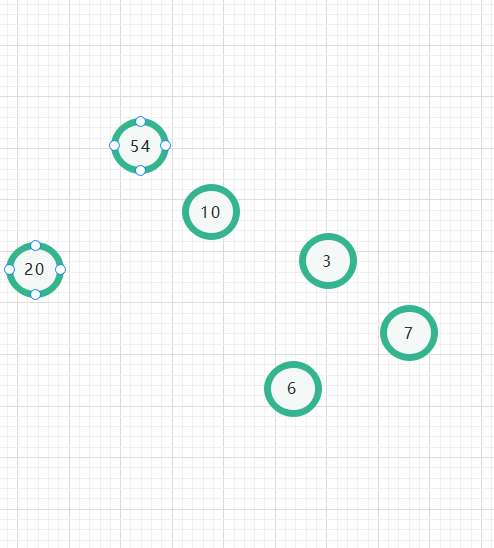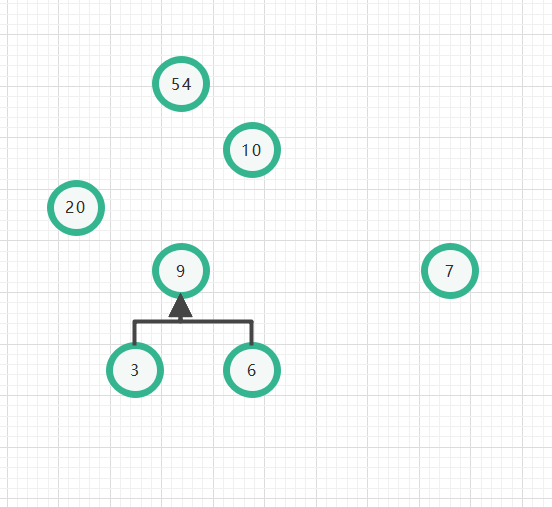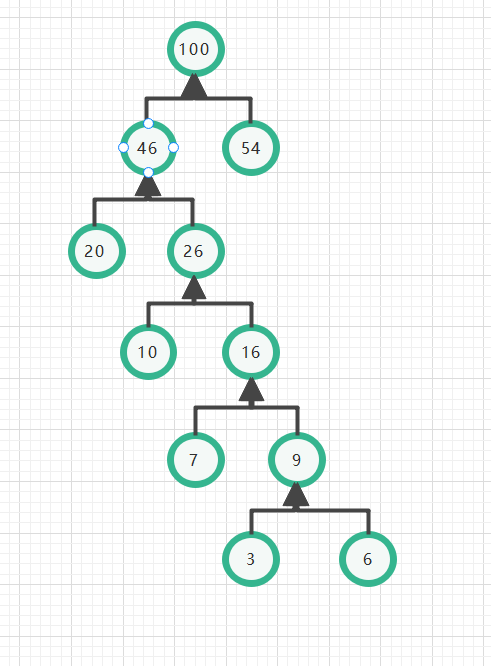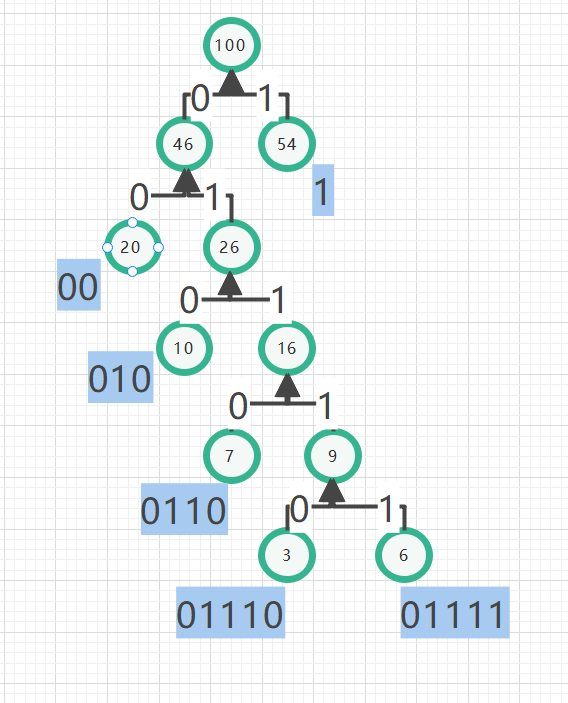Huffman tree
definition:
Given N weights as N leaf nodes, a binary tree is constructed. If the weighted path length of the tree reaches the minimum, such a binary tree is called the optimal binary tree, also known as Huffman tree. Huffman tree is the tree with the shortest weighted path length, and the node with larger weight is closer to the root.
understand:
Take chestnuts for example: if you have a wardrobe with ABCDEF, there are 6 clothes in total, but the frequency of wearing each clothes is different, 54% (ask is like wearing), 10%, 6%, 3%, 7%, 20%
So now the question is, how can you put your clothes in order to avoid making a mess of the wardrobe every time you look for clothes?
The answer must be to put the one with high frequency in your nearest place
you 're right!! Huffman tree is like this
Let's see how to build a Huffman tree to complete this operation

Just remember one sentence: find the two smallest vertices to merge

Then keep repeating, keep repeating~~

Obviously~~~
You can find
Each of its leaves is clothes, and the root of the tree with the highest frequency is the nearest
This forms a Huffman tree
Here's the point
Huffman coding
We know that there are many coding methods, such as ASCII coding, binary coding and so on
A Huffman code is introduced below
Or the clothes on it
We stipulate that the right subtree is 1 and the left subtree is 0 (that is, looking right is 1 and looking left is 0)
You can analyze it according to the figure

For the above clothes, we can use ASCII coding or binary coding
Of course, Huffman coding can also be used
Let's analyze which is the most efficient (that is, coding with the shortest code length)
A
S
C
I
I
:
8
b
i
t
ASCII: 8bit
ASCII: 8bit
two
enter
system
:
3
b
i
t
Binary: 3bit
Binary: 3bit
Huffman coding: because of the indefinite length of Huffman coding, we require the average code length ACL
A
C
L
=
0.54
∗
1
+
0.20
∗
2
+
0.10
∗
3
+
0.07
∗
4
+
0.09
∗
5
=
1.97
ACL=0.54*1+0.20*2+0.10*3+0.07*4+0.09*5 = 1.97
ACL=0.54∗1+0.20∗2+0.10∗3+0.07∗4+0.09∗5=1.97
obviously!! Huffman is smaller than the other two coding lengths
Next, we use code to realize the construction of Huffman tree
Better understanding combined with tables~~~
This form has also become a codec table. It can be said that if you use Huffman coding to send messages to your friends, the internet police will never find it no matter how powerful it is
| node | character | probability | parent node | left node | right node | code |
|---|---|---|---|---|---|---|
| 1 | A | 54 | 11 | 0 | 0 | 1 |
| 2 | B | 10 | 9 | 0 | 0 | 010 |
| 3 | C | 6 | 7 | 0 | 0 | 01111 |
| 4 | D | 3 | 7 | 0 | 0 | 01110 |
| 5 | E | 7 | 8 | 0 | 0 | 0110 |
| 6 | F | 20 | 10 | 0 | 0 | 00 |
| 7 | 9 | 8 | 4 | 3 | ||
| 8 | 16 | 9 | 5 | 7 | ||
| 9 | 26 | 10 | 2 | 8 | ||
| 10 | 46 | 11 | 6 | 9 | ||
| 11 | 100 | 10 | 1 |
Huffman tree node structure
struct HTNode
{
char ch; //Corresponding letters, such as a
int weight;//The number of occurrences of letters, such as 1000 occurrences of a
int parent;
int left;
int right;
char* code;
};
Initialize tree structure
void InitHTTable(int AsciiCount[], HTNode* &HT)
{
for(int i = 0; i <= 128; i ++) AsciiCount[i] = 0;//Initialize array to 0
AsciiCount[65] = 54;
AsciiCount[66] = 10;
AsciiCount[67] = 6;
AsciiCount[68] = 3;
AsciiCount[69] = 7;
AsciiCount[70] = 20;
HT=new HTNode[2 * 6];//Generate dynamic space [1...2n-1]
int CurrentASCII=0;//Current ASCII code
HT[0].weight=0;
for(int i = 1; i <= 6; i ++)
{
while(AsciiCount[CurrentASCII] == 0)//There may be a break in ASCII. Find the character whose count is not zero
CurrentASCII++;
HT[i].ch = CurrentASCII;//j is the ASCII code of the character whose count is not zero
HT[i].weight = AsciiCount[CurrentASCII];//This is the number of occurrences of the character j as Huffman's weight
HT[i].parent = 0;//Initialize parents
HT[i].left = 0;//Initialize left child
HT[i].right = 0;//Initialize right child
CurrentASCII++;//Next ASCII code
}
}
Find the two smallest probabilities
void selectMin(HTNode* &HT,int end,int &min1,int &min2)
{//In the array HT[1...end], find the two with the smallest weight
int i;
min1 = 0;
min2 = 0;
for(i = 1; i <= end; i++)
{
if(HT[i].parent != 0)//If this node already has parents, it means that it is already in the tree
continue;
else
{
if(min1 == 0)
min1 = i;//Note the minimum value
else if(HT[i].weight < HT[min1].weight)//Smaller value found
min1 = i;
}
}
for(i = 1; i <= end; i++)
{
if(HT[i].parent != 0 || i == min1)
continue;
else
{
if(min2 == 0)
min2 = i;
else if(HT[i].weight < HT[min2].weight)
min2 = i;
}
}
if(min1 > min2)
{//Make sure min1 is minimum
int t = min1;
min1 = min2;
min2 = t;
}
}
Build a tree
void createHT(HTNode* &HT)
{//Create Huffman tree and get Huffman code
int i = 0;
for(i = 0; i <= 11; i++)
{//Initialize all Huffman tables
HT[i].parent=0;
HT[i].left=0;
HT[i].right=0;
}
for(i = 7; i <= 11; i++)
{//Form Huffman tree
int min1, min2;
selectMin(HT, i - 1, min1, min2);//Select two minimum values from the i-1 items in front of the Huffman table, min1 is the minimum, and the left subtree of the constructed Huffman tree is small
HT[min1].parent = i;
HT[min2].parent = i;
HT[i].weight = HT[min1].weight + HT[min2].weight;//Two small probabilities synthesize a node
HT[i].left = min1;
HT[i].right = min2;
}
//Huffman node generating leaves
int code_length = 0;
for(i = 1; i <= 6; i++)
{
char code[128];//Save Huffman code
int j = i, k = 0;
while(1)
{
int parentPosition = HT[j].parent;
if(parentPosition == 0)
{//This is the root node
code[k] = '\0';
HT[i].code = new char[k + 1];
for(int x = 0; x < k; x++)
HT[i].code[x] = code[k - 1 - x];
HT[i].code[k] = '\0';
printf("%c : %d : %s\n",HT[i].ch, HT[i].weight, HT[i].code);// Output character probability and coding value
break;
}
if(HT[parentPosition].left == j)
code[k++] = '0';
else
code[k++] = '1';
j = parentPosition;
}
}
}
Sprinkle flowers at the end 🌼🌻🌼🌻